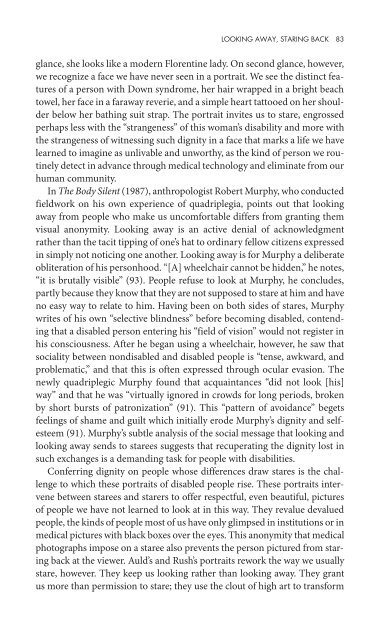Staring how we look sobre la mirada.pdf - artecolonial
Staring how we look sobre la mirada.pdf - artecolonial
Staring how we look sobre la mirada.pdf - artecolonial
Create successful ePaper yourself
Turn your PDF publications into a flip-book with our unique Google optimized e-Paper software.
THE UNEXPECTED AND EXTRAORDINARY<br />
A SOCIAL RELATIONSHIP 37<br />
Expectations about the ways bodies should <strong>look</strong> and work affect <strong>how</strong> <strong>we</strong><br />
see each other as <strong>we</strong>ll. “The ordinary—and the interruption to the expected<br />
experience,” according to Geoffrey C. Bowker and Susan Leigh<br />
Star, “are delicate constructions made and remade every day” (1990, 296).<br />
Take for example the seemingly straightforward state of “attractiveness.”<br />
Physical attractiveness is a form of social capital. The more attractive one’s<br />
self-presentation, the more competent and esteemed one is thought to be,<br />
which trans<strong>la</strong>tes into economic and social advantage. What social scientists<br />
term “expectation states theory” analyzes group interaction to reveal<br />
<strong>how</strong> a complex <strong>we</strong>b of status cues—some categorical, like race, gender,<br />
and ability and some traits, like articu<strong>la</strong>teness or confidence—works to determine<br />
“the status hierarchy where members with high expectations will<br />
participate more and will be more influential than members with low expectations”<br />
(Eise<strong>la</strong>nd and Johnson 1996, 72). In other words, people who<br />
cannot convincingly present high status cues are devalued. Expectation<br />
states theory suggests then that attractiveness is not so much a collection<br />
of positive bodily attributes, but rather it is the successful presentation of<br />
a normative standard. Simply put, expectation states theory <strong>la</strong>ys out <strong>how</strong><br />
beauty really is in the eye of the beholder.<br />
Within the ever-shifting circumstances that determine what <strong>we</strong> expect<br />
when <strong>we</strong> confront each other, some people are less successful in achieving<br />
the ordinary and are thus accorded uncivil attention. Indeed, some of us<br />
cannot be visually unremarkable, regardless of <strong>how</strong> <strong>we</strong> structure our performances<br />
of self in everyday life. When bodies begin to malfunction or <strong>look</strong><br />
unexpected, <strong>we</strong> become aware of them. They expose themselves by becoming<br />
bodies rather than tools of our intentionality. Sick, disabled, or pained<br />
bodies both experience and invoke what Drew Leder (1990) calls “dysappearance,”<br />
meaning that their differences from acquiescent bodies make<br />
them appear to us and others. 6 Extraordinary-<strong>look</strong>ing bodies demand attention.<br />
The sight of an unexpected body—that is to say, a body that does not<br />
conform to our expectations for an ordinary body—is compelling because it<br />
disorders expectations. Such disorder is at once novel and disturbing. This<br />
interruption of expectations, of the visual status quo, attracts interest but can<br />
also lead to disgust, according to William Ian Miller (1997). Unusual bodies<br />
are “unsettling because they are disordering; they undo the comp<strong>la</strong>cency<br />
that comes with disattendability; they force us to <strong>look</strong> and notice, or to suffer<br />
self-consciousness about <strong>look</strong>ing or not <strong>look</strong>ing. They introduce a<strong>la</strong>rm<br />
and anxiety by virtue of their po<strong>we</strong>r to horrify and disgust.” Such bodies<br />
fascinate; they demand that <strong>we</strong> “sneak a second <strong>look</strong>” (Miller 1997, x).


